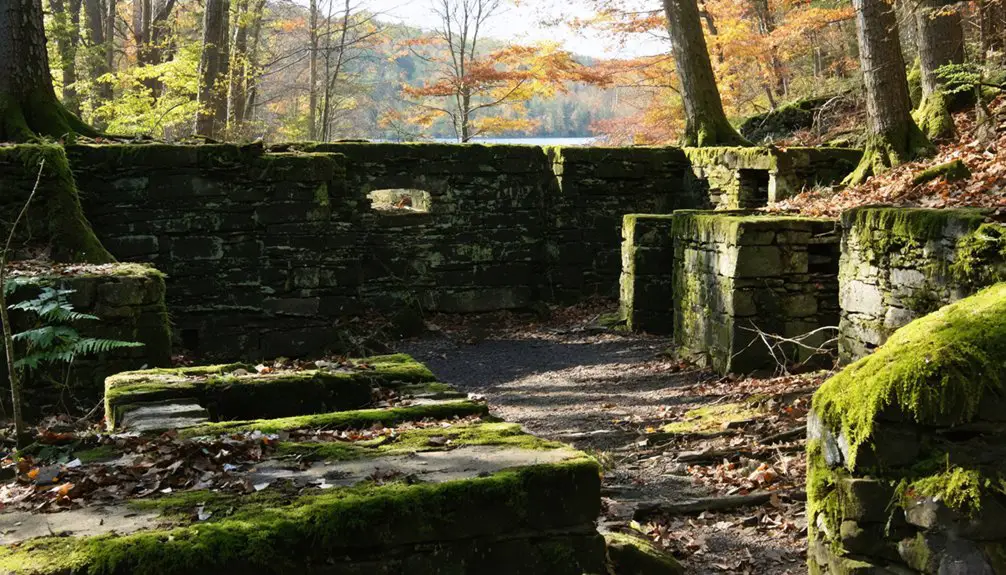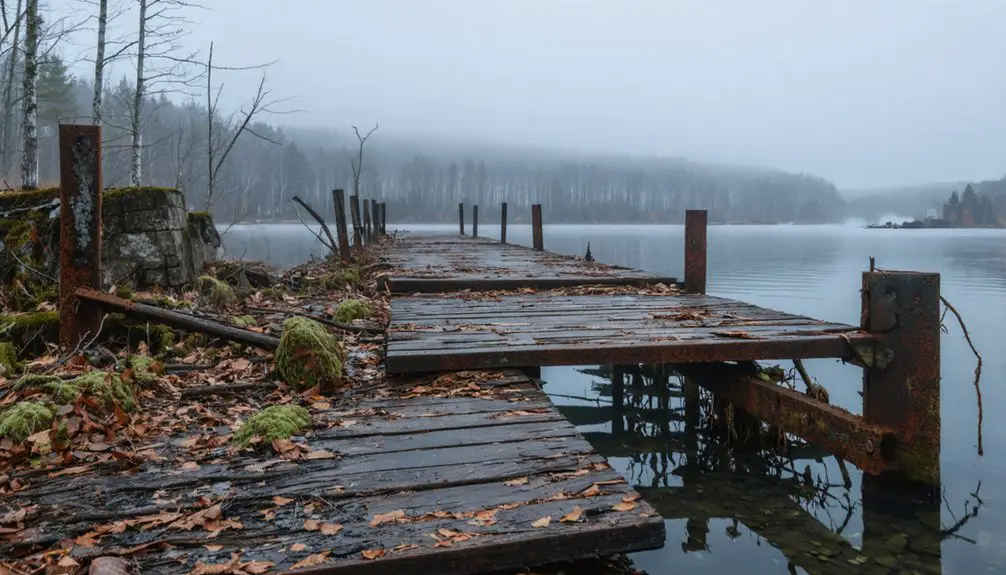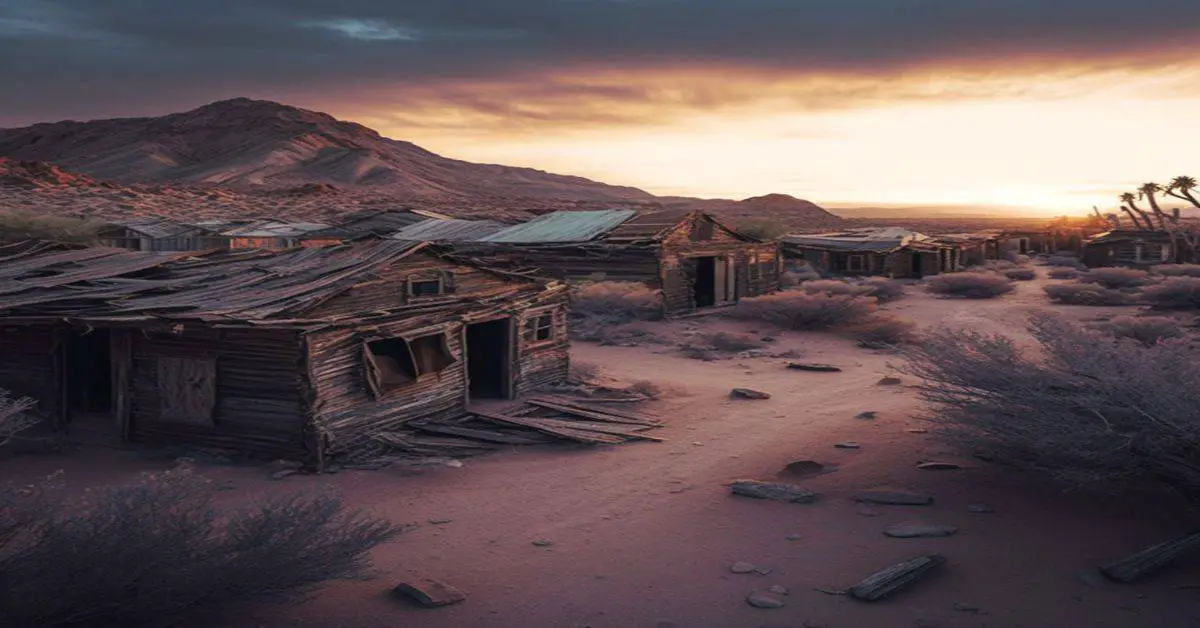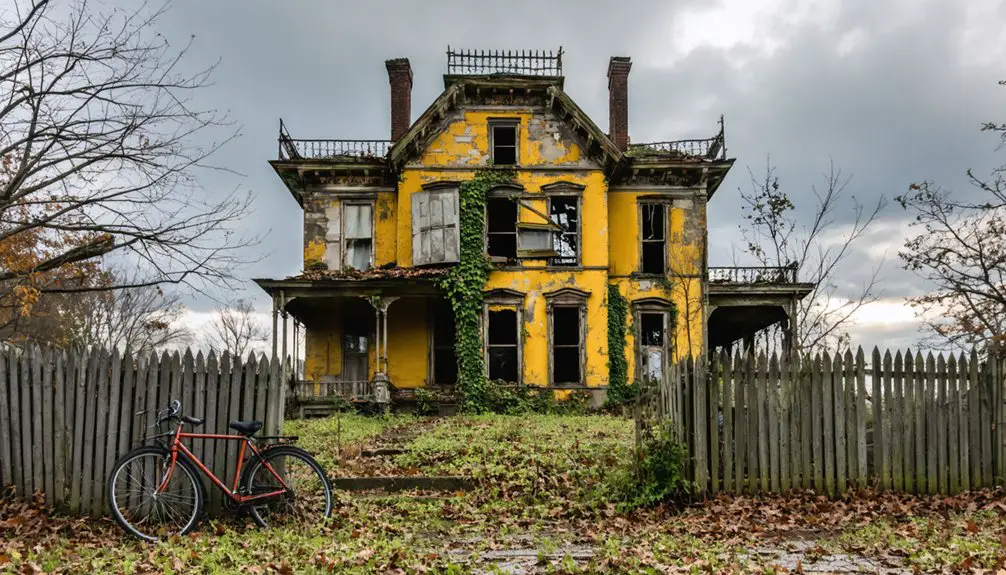Once a bustling timber and tanning hub, Conklingville, NY now lies beneath the waters of Great Sacandaga Lake. You’ll find this ghost town‘s story began in the 1790s with pioneer settlers and peaked in the mid-1800s through its industrial growth. The 1930 construction of Conklingville Dam forced residents to abandon their homes, burning many structures before the valley’s flooding. Today’s recreational paradise holds countless untold tales beneath its surface.
Key Takeaways
- Conklingville was a thriving settlement in New York that became submerged underwater following the construction of the Sacandaga Reservoir in 1922.
- Residents were forcibly displaced from their homes, with some buildings burned before flooding and families desperately protesting their removal.
- The town’s transformation from industrial center to ghost town occurred when the Hudson River Regulating District initiated the dam project.
- Original structures and properties now lie beneath the Great Sacandaga Lake, with only historical markers indicating the town’s former location.
- The submerged town’s history is preserved through local museums, artifacts, and interpretive programs that document the community’s displacement.
Early Settlement and Pioneer Life
While the Sacandaga Valley had long served as hunting grounds for the Mohawk and Oneida tribes, white settlement in what would become Conklingville began between 1791 and 1797.
David Johnson, Jonas Bond, and Phineas Austin were among the first to brave the untamed wilderness, followed by the Groves family and Nicholas Flansburgh from Schenectady County.
You’d find these early pioneers facing immense struggles – dense forests with no roads, the need to clear land for farming, and limited resources for survival.
Without formal governance until 1819, settlers relied on their own determination and ingenuity.
Henry Paul’s construction of the first saw- and grist-mill in 1805 marked a significant development, finally enabling local grain processing.
The pioneers hunted, trapped, and fished while gradually establishing farms and building a community from the ground up.
The area’s sandy, light soil presented additional challenges for early farming efforts.
The abundant hemlock bark attracted settlers who established tanneries as a vital industry in the region.
The Rise of Timber and Tanning Industries
As abundant hemlock and pine forests blanketed the Adirondack region, Conklingville’s transformation into a bustling industrial center began in the early 1800s.
You’d find timber innovations emerging as two-man teams wielded axes through virgin forests, while water-powered sawmills churned out lumber along the Sacandaga River’s edge.
The tanning techniques of the era depended heavily on hemlock bark, which workers stripped from May through August when the sap flowed freely.
The Whip Poor Will and Colonel steamboats navigated the river’s challenging conditions, transporting precious bark to the tannery.
When these vessels ran aground on sandbars, you’d see entire communities working together to raise dam water levels, showcasing the remarkable spirit of cooperation that defined Conklingville’s industrial heyday.
By 1860, the region reflected the broader national trend as a fourth of forests had been cleared for various industrial uses.
Gurden Conkling established a tannery in Conklinville in 1848, marking a significant expansion of the local leather industry.
Daily Life in 19th Century Conklingville
Since the late 18th century, you’d find Conklingville’s earliest settlers carving out a precarious existence through hunting, trapping, and subsistence farming along the Sacandaga River.
Pioneer hardships dominated daily routines as families battled wildlife threats while tending to livestock and crops. Seasonal rhythms dictated the pace of life, with communities gathering at churches and schoolhouses to share resources and labor. With access to 9416 acres of woodland, residents relied heavily on timber resources for building materials and fuel. The valley thrived as a logging hub until its eventual submergence in 1930.
Your typical day would involve:
- Protecting livestock from bears, wolves, and panthers that prowled nearby
- Working the cleared fields with tools passed down through generations
- Preserving food in preparation for harsh winters ahead
- Trading with neighbors for essential supplies and participating in community labor exchanges
The log homes you’d build would stand as evidence of self-reliance, while strong social bonds formed through shared challenges of frontier life.
The Great Dam Project Begins
The peaceful rhythms of Conklingville’s frontier life came to an abrupt end in 1922 when the New York State Legislature established the Hudson River Regulating District.
You’d have seen the massive changes unfold as engineer Edward Haynes Sargent’s ambitious plans transformed your valley into New York’s largest reservoir.
The project’s initial funding came primarily from private industries, who contributed 95.5% of the $12 million cost, with flood-affected communities covering the rest.
The dam reached an impressive 95 feet in height, making it a dominating presence in the Sacandaga Valley landscape.
You’d have witnessed extraordinary engineering challenges: workers battling floods during construction, installing three massive Dow valves, building 10 new bridges, and laying miles of highway.
Despite fierce local opposition and a railroad lawsuit resulting in a $1.6 million settlement, the state’s determination to prevent disasters like the 1913 flood meant there’d be no stopping the dam’s completion in 1930.
On March 27, 1930, the closing of three large Dow valves officially began the impoundment of water that would create the Great Sacandaga Lake.
Community Displacement and Relocation
While New York State’s determination to build the reservoir remained unwavering, local residents faced a devastating reality: mandatory displacement from their ancestral homes.
The displacement trauma touched every aspect of community life, as families witnessed their cultural heritage being systematically dismantled. The massive project carried a price tag of $12 million to transform the valley into the Great Sacandaga Lake.
Local inhabitants endured the heartbreaking sight of their homes being burned to ashes before the flooding began.
You’ll find these haunting scenes from the forced relocation:
- Farmers watching their generational lands disappear, along with traditional industries like rake and washboard manufacturing.
- Community members desperately tying themselves to homes in protest.
- Workers exhuming 4,000 graves, with reports of coffins later surfacing during flooding.
- The lone First Christian Church of Day being moved to higher ground, while other churches faced demolition.
Those who couldn’t negotiate fair compensation faced economic hardship, forever changing the valley’s rural way of life.
Tales of the Submerged Valley
Beneath the shimmering waters of Great Sacandaga Lake lies a haunting memorial to sacrificed communities, where ten towns now rest in their watery grave.
You’ll find submerged stories of nearly 12,000 homes, farms, and churches that couldn’t escape the flood, many deliberately burned before the waters rose.
Local lore speaks of ghostly encounters tied to the 3,900 graves that were hastily exhumed, with some remains still trapped beneath the lake’s surface.
You might hear tales of witches who cursed the dam, hoping it would fail, or accounts of mysterious lights dancing above the water at night.
These stories reflect the deep wounds of displaced families who lost not just their homes, but their connection to ancestral burial grounds, creating a powerful blend of historical tragedy and supernatural legend.
Modern Day Legacy and Recreation

Today you’ll find the former site of Conklingville transformed into a vibrant recreational hub, where visitors enjoy fishing, boating, and kayaking on the Sacandaga Reservoir’s expansive waters.
You can explore the area’s rich history through interpretive signs and historical markers that detail the submerged town’s past, while local museums preserve artifacts and stories from the displaced community.
The reservoir’s creation has established a unique blend of outdoor activities and heritage tourism, with guided tours and annual events commemorating Conklingville’s legacy while supporting modern recreational opportunities.
Reservoir Activities Today
The Great Sacandaga Lake, created by the historic Conklingville Dam, has evolved into a vibrant recreational hub that supports year-round activities including boating, fishing, swimming, and whitewater rafting.
You’ll find diverse recreational opportunities while the dam’s operators carefully balance environmental impacts through sustainable management practices.
- Cast your line from ADA-compliant fishing piers designed for accessibility
- Navigate your boat across the reservoir’s regulated waters in summer
- Experience thrilling whitewater rapids on the Sacandaga River
- Explore protected wildlife habitats along the shoreline
The $40 million rehabilitation project, starting June 2025, won’t disrupt your water activities, as engineers maintain normal water levels throughout construction.
Local authorities and district personnel guarantee your safety while preserving the lake’s natural resources for future generations.
Historical Tourism Impact
While modern visitors enjoy Great Sacandaga Lake‘s recreational offerings, they’re experiencing a destination shaped by profound historical changes.
The 1930 construction of Conklingville Dam transformed the Sacandaga Valley from a community into a recreational hub, forcing historical preservation efforts that included relocating the First Christian Church of Day and exhuming 4,000 graves.
You’ll find today’s tourism economy thriving through waterfront businesses, marinas, and seasonal cottages that emerged during the post-WWII boom.
The lake’s rebranding in the 1960s enhanced its appeal, building upon the region’s pre-flood legacy as a resort destination.
Through local museums, documentaries, and interpretive programs, you can explore the complex narrative of a community that sacrificed its original identity to become one of New York’s premier waterfront destinations.
Frequently Asked Questions
What Underwater Artifacts Have Divers Discovered in the Former Town Site?
You’ll find underwater exploration has revealed submerged history through building foundations, railroad tracks, bridge remnants, and household items, though specific artifact discoveries remain largely undocumented in official records.
How Much Compensation Did Displaced Residents Receive for Their Properties?
While you’d expect fair displaced compensation, exact property valuation figures aren’t documented in available sources, though New York State likely aimed to pay market value for Conklingville properties during that period.
Are There Any Surviving Structures From Original Conklingville Above Water Today?
You won’t find any original Conklingville structures above water today, except for the First Christian Church of Day, which was relocated. All other historic preservation efforts couldn’t save the submerged relics.
What Was the Estimated Total Population of Conklingville Before Flooding?
Like a small fish in a vast river, Conklingville’s exact population remains elusive, but historical population estimates suggest several hundred residents lived there, as it was one of ten communities totaling 3,000 valley inhabitants.
Did Any Residents Refuse to Leave During the Forced Relocation?
Yes, resident stories confirm some locals actively resisted relocation, even tying themselves to homes. Despite their resistance to relocation reasons, authorities forcibly removed them and burned their properties down.
References
- https://www.townofday.com/historian.html
- http://www.saratoganygenweb.com/Sylvester/chap45.html
- https://en.wikipedia.org/wiki/Conklingville_Dam
- https://www.hmdb.org/m.asp?m=180114
- https://www.visitsacandaga.com/history-lorraine-frasier/
- http://www.saratoganygenweb.com/Sylvester/chap42.html
- https://townhadley.digitaltowpath.org:10096/content/History
- https://www.newyorkalmanack.com/2021/11/sacandaga-river-steamboats/
- https://www.visitsacandaga.com/sacandaga-logging-and-floods-2/
- https://www.nps.gov/articles/adirondacks-lumber-industry-forest-conservation.htm



